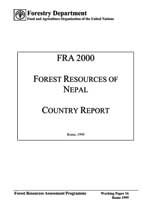

Rome, 1999

The Forest Resources Assessment Programme
Forests are crucial for the well-being of humanity. They provide foundations for life on earth through ecological functions, by regulating the climate and water resources, and by serving as habitats for plants and animals. Forests also furnish a wide range of essential goods such as wood, food, fodder and medicines, in addition to opportunities for recreation, spiritual renewal and other services.
Today, forests are under pressure from expanding human populations, which frequently leads to the conversion or degradation of forests into unsustainable forms of land use. When forests are lost or severely degraded, their capacity to function as regulators of the environment is also lost, increasing flood and erosion hazards, reducing soil fertility, and contributing to the loss of plant and animal life. As a result, the sustainable provision of goods and services from forests is jeopardized.
FAO, at the request of the member nations and the world community, regularly monitors the world’s forests through the Forest Resources Assessment Programme. The next report, the Global Forest Resources Assessment 2000 (FRA 2000), will review the forest situation by the end of the millennium. FRA 2000 will include country-level information based on existing forest inventory data, regional investigations of land-cover change processes, and a number of global studies focusing on the interaction between people and forests. The FRA 2000 report will be made public and distributed on the world wide web in the year 2000.
The Forest Resources Assessment Programme is organized under the Forest Resources Division (FOR) at FAO headquarters in Rome. Contact persons are:
Robert Davis FRA Programme Coordinator [email protected]
Peter Holmgren FRA Project Director [email protected]
or use the e-mail address: [email protected]
The Forest Resources Assessment (FRA) Working Paper Series is designed to reflect the activities and progress of the FRA Programme of FAO. Working Papers are not authoritative information sources – they do not reflect the official position of FAO and should not be used for official purposes. Please refer to the FAO forestry website (www.fao.org/fo ) for access to official information.
The FRA Working Paper Series provides an important forum for the rapid release of preliminary FRA 2000 findings needed for validation and to facilitate the final development of an official quality-controlled FRA 2000 information set. Should users find any errors in the documents or have comments for improving their quality they should contact either Robert Davis or Peter Holmgren at [email protected].
Paper drafted by:
Kailash Govil,
Regional Project Coordinator,
GCP/RAS/162/JPN
Editorial production:
Patrizia
Pugliese,
FRA Programme
3.7 Institutions of governance
4.3 Forests
4.3.1 Tropical Zone (below 1 000 m)
4.3.2 Subtropical Zone (1,000 to 2,000 m)
4.3.3 Temperate zone (2,000 to 3,000 m)
4.3.4 Sub alpine zone (3,000 to 4,000 m)
4.3.5 Alpine zone (4,000-5,000 m)
4.3.6 Nival (above 5,000 m)
4.7 Change in growing stock over time
4.8 Deforestation and degradation
4.11 Conservation of biodiversity
4.13 Assessment of biodiversity
5 Factors Affecting Forest Resources
5.5 Human resource development
5.7 Inter and intra-sectoral growth
6.5 Non-timber forest products
7 Forest planning and management
7.4 The forest planning process
7.5 Forestry and five year plans
8.3 National Parks and Wildlife Conservation Act (NPWCA), 1973
8.4 Environment Protection Act (EPA), 1996
8.5 Aquatic Animals Protection Act (AAPA), 1961
8.6 Soil and Watershed Conservation Act (SWCA), 1982
8.7 Water Resources Act (WRA), 1992